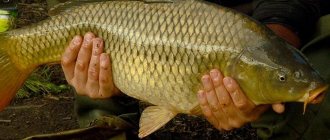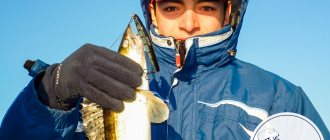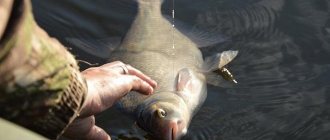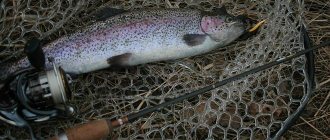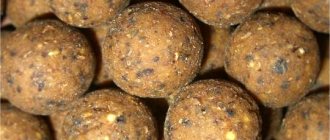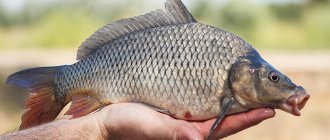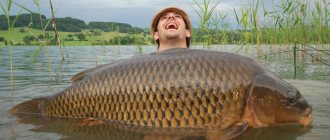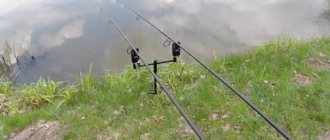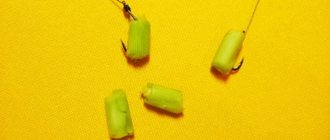Carp fishing is very exciting and interesting. Carp is the desired prey for every fisherman. This is due to a number of factors.
Firstly, this is a fairly cautious and strong fish, and its habitat is quite wide and varied, and secondly, the fish can reach quite large sizes.
That is why, in order to catch carp, you need to know the fish’s habits, habitats, lifestyle, have the appropriate tackle and equipment, as well as have good dexterity and perseverance.
What do carp bite on in May?
When spring comes, the ice on all reservoirs begins to gradually melt and become free of ice cover. Most fish activate their vital activity at this time.
L.P. Sabaneev also noted that the first zhor of carp begins immediately after the ice melts. Then the activity subsides and the fish gradually begins to prepare for spawning, which in most reservoirs in central Russia occurs in May, after the water has warmed up sufficiently.
The main food for carp at this time is: bloodworms, worms, insects, crustaceans that live in the reservoir. Moreover, there is still little aquatic vegetation. Therefore, bait of animal origin is most often used as bait in May.
How to catch carp
Every fishing enthusiast knows that not only bait and complementary foods are important, but also fishing tactics. Each fish has its own characteristics and carp is no exception. By following some recommendations, a fisherman can significantly increase his chances of a big catch.
- It is worth fishing in good weather. It is recommended to choose morning hours. During the day and evening, carp fishing is worse than at dawn. Night fishing for carp is only possible in well-fed areas or in reservoirs with high temperatures.
- The equipment must be rethrown at least every 30 minutes. This is necessary so that the bait has an attractive appearance and its smell does not deteriorate.
- You should not wear bright things. The fish swim close to the shore, and wearing bright colors can spook them. In May it is better to use camouflage for carp fishing.
- It is worth inspecting the reservoir to determine the most advantageous fishing spot.
- It is best to feed in several places where the water temperature is quite high. This approach will help increase your catch.
- At least 30 feeders should be made at the selected point before you start throwing bait.
If there is no bite, don't be upset. It is possible that the wrong bait was selected. Fishermen should not be afraid to change feeding or experiment. Spring fish are omnivorous, love a variety of foods and can bite on completely different baits.
Seasonal Fishing Guides
In order to catch carp regularly, and not occasionally, you should take into account numerous conditions and one of the main ones is the season. For example, in winter, when the water temperature is low, the fish's metabolism slows down. Therefore, when fishing, it is recommended not to overfeed it.
The best option is spot feeding using PVA bags. In early spring, when the water is just starting to warm up, you should look for carp in shallow water, near thickets of aquatic vegetation.
In the summer heat, the fish goes to depth, so for fishing you should choose places with depths of 1.5 meters or more. In the fall, carp gather in schools where they stand in holes—that’s where they should be caught.
Seasonal differences in carp fishing concern not only their habitats, but also bait, groundbait and tackle. Currently, many fishermen, especially carp anglers, use bite activators - attractants.
At the same time, you should know that when fishing in cold water, the most effective are pungent odors - alcohol-based. But in the summer, in warm water, sweet oil-based scents give the best results.
As for bait, in the fall and spring baits of animal origin are most often used (bloodworms, maggots, etc.), and in the summer of vegetable origin - steamed wheat, pearl barley, corn, porridge (wheat, pea and semolina), boiled potatoes and specially mixed dough.
When is the best time for carp to bite?
During the year, you can observe several periods when the carp bite is most active:
- immediately after the ice melts (a very short period in time and therefore often goes unnoticed among fishermen).
- immediately after spawning (mid-May - early June).
- August - September (until there are sudden temperature changes).
The best times of day for carp fishing are considered to be early morning, night and early evening. A big role in the activity of fish is played by: water temperature, atmospheric air pressure, and phases of the moon. In particular, it was noticed that when the pressure decreases, the bite improves.
In general, carp do not like sudden changes in weather and their bite may worsen or stop altogether a day or two before the weather changes.
Where to look for carp in spring
As already mentioned, the activity of carp in spring is significantly influenced by the temperature of the water in the reservoir. The lower it is, the lower the activity of the carp. Therefore, in spring, the axiom that fish look “where deeper” is not always justified. Even such a cautious fish as large carp prefers to stay in the coastal zone at a shallow depth of up to one meter and twenty centimeters. In summer, at such a depth you can only catch small carp, and even then by accident. And in the spring, if you move to a depth of more than 2 meters, you may not see a single bite all day. On the sandy spits of the coastal strip, the water warms up the fastest, which attracts large fish to such places to bask in the sun. In addition, unlike summer, in spring it is hardly worth waiting for bites at dawn , when the reeds and withered grass turn frosty, and the water is icy, like in winter. Sometimes, on the contrary, all the bites begin at sunrise and even closer to lunch.
Features of carp fishing in May
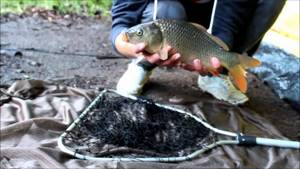
May marks one of the periods of active feeding for this fish. At this time, the carp is very active and can be caught both in the shallows and in its permanent habitat. Here it is important to know the migration routes of fish during daily exercise (morning and evening). Most likely, carp can be found at this time of year in thickets of reeds and other aquatic vegetation.
They also pay attention to snags, whirlpools, areas of reservoirs with sharp changes in depth, and often approach steep banks.
In May, carp are most often caught using a float rod, although in some places fishing with bottom or feeder gear can be quite effective. But in principle they are used more in summer and autumn.
Baits and lures
The nozzle should always be selected taking into account the following factors:
- features of reservoirs - standing water or current;
- bottom type and color;
- depths;
- presence of vegetation;
- method of fishing.
When fishing for carp, bait plays an important role. There are also subtleties and tricks here. For example, if fishing is carried out on a current, it needs to be lowered into a net from which it will gradually be washed out.
Another option is to scatter pre-prepared bombs made from clay, porridge, sunflower cake, hemp and crushed worms. There can be a huge number of options here, and this is due to the fact that there is now a large selection of ready-made mixtures on sale. In fact, every experienced fisherman has a couple of his own signature recipes.
Bait recipes
Moreover, they can be either the simplest or more complex - combined.
The first include:
- Steamed grains.
- Boiled potatoes.
- Bread with the addition of ground seeds, aromatic oil, and so on.
- Corn, and it is suitable in different forms - fresh, boiled and even canned.
Dough with honey and egg yolk: knead the dough from flour and water, add two raw yolks and one teaspoon of honey. The resulting mass should be soft and stick well to the hook. Wrap the finished mixture in a damp cloth.
Lures and bait
In spring, carp bite better on animal baits, but on some warm days, they may also want plant food. The carp feeds little by little, this is due to the fact that its belly is filled with milk and caviar. Therefore, bait should be treated with extreme caution, as there is a risk of overfeeding the fish.
Lures
Worms, bloodworms and maggots are suitable as spring animal baits.
Fishing with a worm works best. In second place is the bloodworm, followed by maggots. Various combinations of these baits also work well when fishing.
Don't forget about traditional corn. Canned corn works best on hot days, towards the middle of the day. Any angler should have all these baits.
Lure
It is better to buy bait for spring carp in the store. When choosing, you need to avoid strongly flavored baits, since in the spring there are already enough odors in the water. In general, there are no odorless baits, and in this regard it is better to give preference to strong odors, such as garlic.
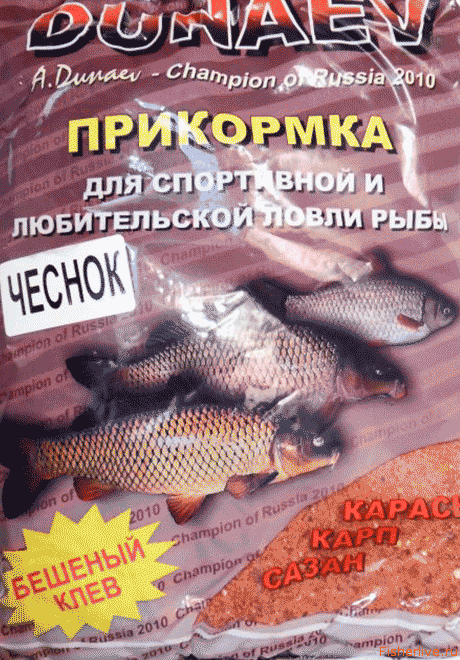
Half a packet of this bait should be mixed with soil in a ratio of 70 to 30, of which 70 is soil. This composition should be used as the main feeding. The rest of the bait needs to be mixed with the bait, and point feeding should be done. Remember that the bait on the hook should be larger and more attractive than in the groundbait.
Carp bait
The most commonly used bait for carp is various porridges mixed with flour, crushed fried hemp seeds and pieces of worms. There are many options here, both in composition and in percentage terms.
Experienced fishermen recommend adding the bait itself to the bait composition. By the way, all the main types of bait can be purchased at a specialized store or prepared independently.
By the way, the second option is more preferable and the most economical in terms of money. But when preparing it yourself, you must take into account the correct proportion.
Promising methods of carp fishing
In addition to the widely used methods of fishing with float and bottom tackle recently, feeder carp fishing is becoming increasingly popular. As practice shows, the largest specimens are caught when caught on the most ordinary feeder.
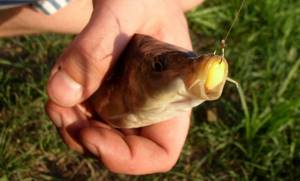
In the autumn, some fishermen catch carp with a spinning rod using a spoon or silicone fish, but this method is still not widespread in our country.
Firstly, when fishing for carp in May, you should definitely study the reservoir for the favorite habitats of this fish, and secondly, its routes, find out which bait this fish bites best at this time of year.
This can be done empirically by asking or observing local fishermen. The important point is that at the moment, absolutely everyone can catch carp in May - the main thing is to take into account the very technology of catching this fish.
Effective tackle
Today, carp are caught with a variety of gear, from the float rod familiar from childhood to a heavy bottom for sea fishing, on the rod of which special rollers are installed instead of guide rings. There is a wide choice, and each fisherman decides for himself what to use for carp. If you don’t have the funds to purchase carp gear, you can limit yourself to a simple spinning rod, using it with bottom or float equipment. The rod should be 3 or more meters long with a lower test limit of at least 50 g. If you don’t force the fishing, such tackle can handle even a trophy specimen. It is advisable to equip it with a spinning reel with a baitrunner.
This mechanism saves the tackle in cases where a large carp bites too sharply. Experienced carp anglers know about the destructive power of the underwater giant; many have seen bent aluminum posts, broken fishing rods, and a fishing line with a diameter of 0.40 mm torn like a hair. For some, just before their eyes, the fishing rod literally flew into the water. All this can be avoided with a baitrunner, who will give the fishing line to the fish and allow the angler to react correctly to the bite: calmly approach, take the rod, and make a normal hook.
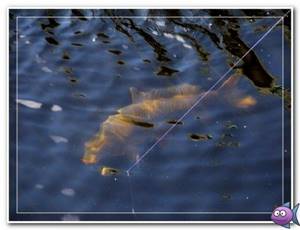
Carp prefers stationary food, so regardless of the type of tackle and equipment, the bait must lie on the bottom. Even when catching river beauties in a small current. To do this, when fishing with a float, the load must exceed its carrying capacity, and several times. For example, if the load capacity of the float is 5 g, then you can put a sliding sinker weighing 15 g. It is sliding so that the fish does not feel resistance when biting.
Read: Fishing for carp on a feeder.
When fishing with a donk with a feeder, you should not get carried away with a large number of hooks. One rocker below the feeder and a branch above it is quite enough (three leashes in total and the same number of hooks). Some people assemble equipment according to the principle that the more hooks the better, but in practice it turns out the opposite. After hooking, carp often goes not from the shore, but to the fisherman and pulls the equipment into the grass, where the remaining hooks “sit tightly” in dense vegetation. Then a break or escape occurs, a strong fish tears either the leash or its lips. Experienced carp anglers advise: to ensure you avoid snags, you need to limit yourself to one hook. In addition, this will save time on replacing nozzles.
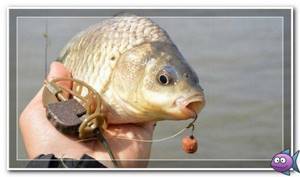
Practical fishing tips
When fishing, the tackle must be quite thin and durable, so saving in this matter is not recommended. Even when fishing in the spring, it would be advisable to use attractants. With all this, you should pay attention to what can be detected directly in a wide variety of places where the water begins to quickly warm up.
Most often, the depth in reservoirs is about 3 meters. The time of day also largely depends - most often it is recommended to fish in the early morning or evening - the later the better. During the day the carp bite weakly.
The main advice when fishing for carp in the spring is to take into account that first of all you need to first study the body of water itself - shallow and deep places, backwaters and snags.
As mentioned above, it is imperative that you carefully select fishing gear - starting with the rods themselves and ending with baits, bait, equipment, fishing lines, and so on.
Farewell words to May carp anglers from Velesovik
And finally, Velesovik will give some tips that will significantly increase the chances of a solid catch:
- Do not make noise. Carp are very sensitive to vibrations, so a loud voice or shaking off dirty shoes on a stump on the shore will definitely be heard by them.
- Disguise yourself. Yes, carp have excellent eyesight. And having found a parking lot near the coastal shallows, you can scare away the fish with just your appearance. Camouflage colors will come in handy. Otherwise, avoid colored and acidic clothing options. The darker and more unassuming, the better.
- Master the "hair". This type of bait attachment has been practiced in carp fishing for a long time. The reason is that the carp does not immediately swallow the bait, but lingers in its mouth for a long time. If you focus on the float and try to hook, the angler will more likely pull out the baited hook than hook the carp.
- Do not hurry. Although carp fishing in May requires precise actions from the angler, it does not mean forcing events. Fishing for such strong fish as carp takes time. Any haste can lead to a line break, or even a reel or rod breakage. And then fishing will have to be stopped ahead of time.
We hope that now you have received the most complete picture of May carp fishing and will be able to personally test them in practice. Hurry up, summer is just around the corner!
